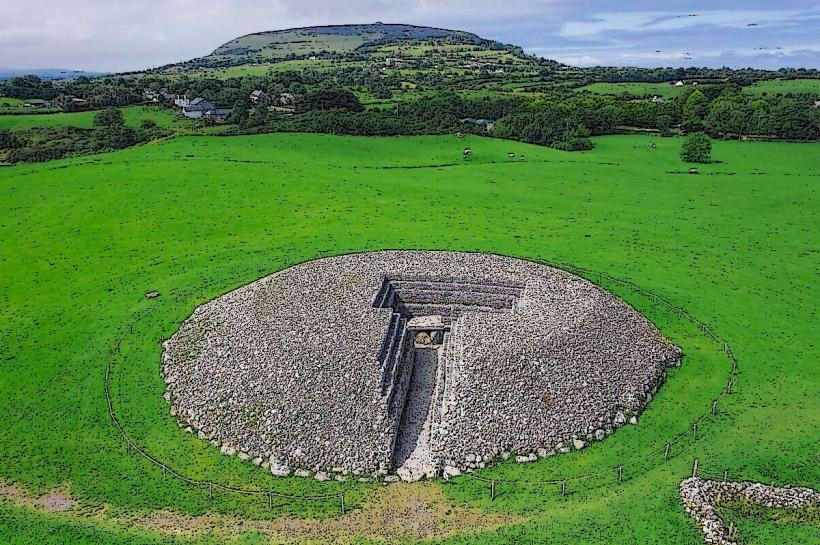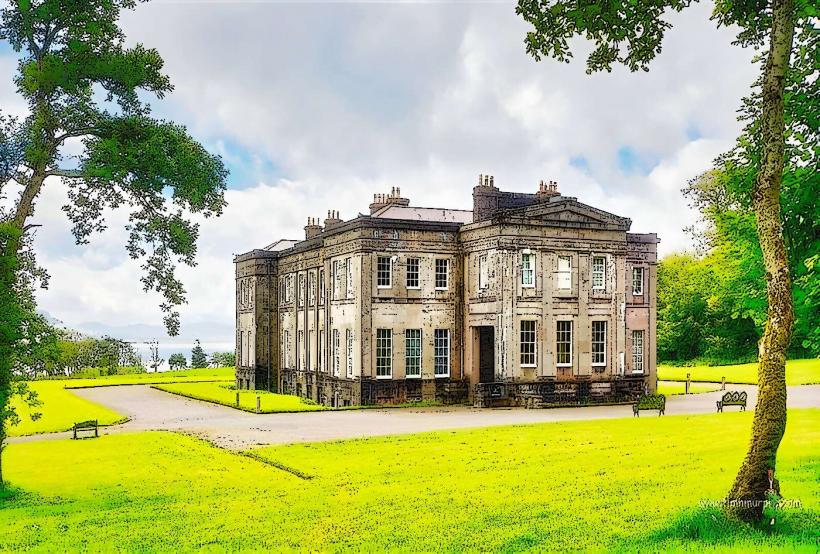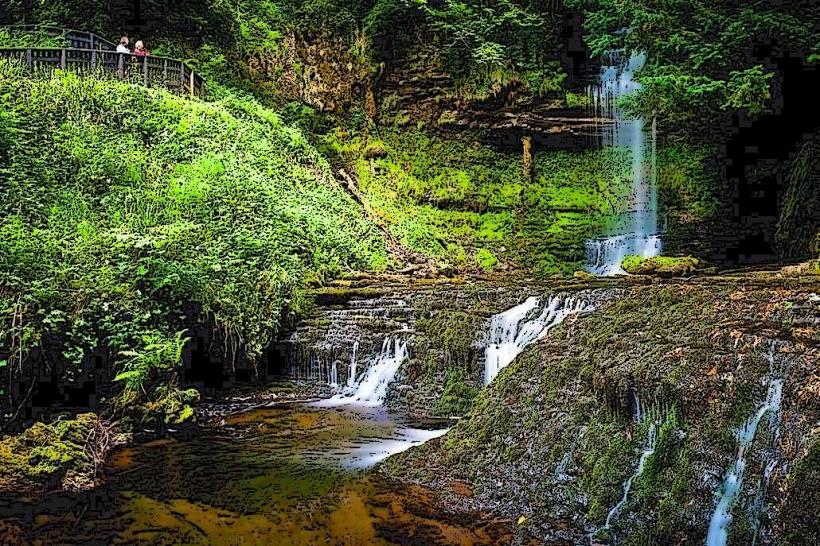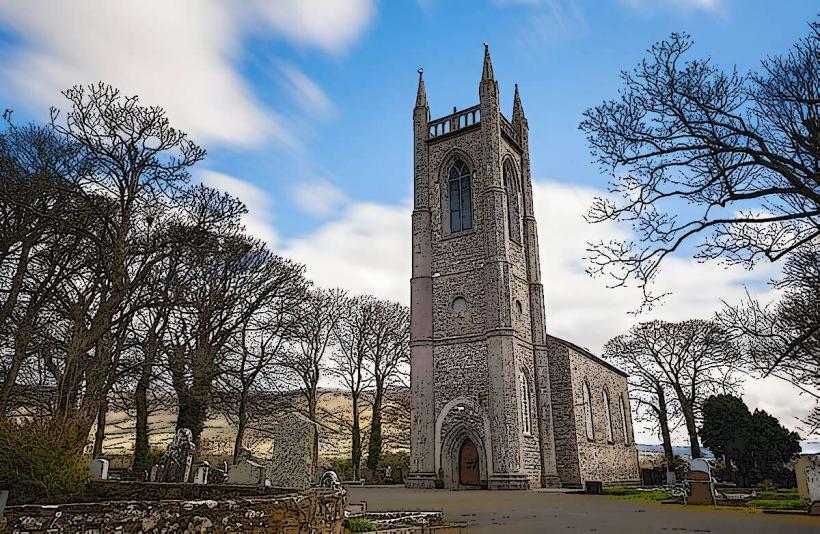Information
Landmark: KnocknareaCity: Sligo
Country: Ireland
Continent: Europe
Knocknarea is a prominent hill located just outside Sligo Town in the northwest of Ireland. It is known for its historical and mythological significance, as well as its stunning views of the surrounding landscape, including the Atlantic Ocean and the nearby Benbulben Mountain. The hill is most famous for the Queen Maeve's Cairn, an ancient burial mound that sits atop the summit.
1. Overview and Location
- Knocknarea stands at 327 meters (1,073 feet) above sea level and is easily visible from a distance due to its distinctive conical shape.
- The hill is located approximately 8 kilometers (5 miles) from Sligo Town, and it is a popular destination for both hikers and history enthusiasts.
- The summit offers breathtaking panoramic views of the Atlantic Ocean, Sligo Bay, Benbulben, and the surrounding countryside, making it a favorite spot for photographers and nature lovers.
2. Historical and Archaeological Significance
- Knocknarea is primarily known for its ancient burial mound, known as Queen Maeve's Cairn, which is located at the summit of the hill. The cairn is an impressive stone structure and is believed to date back to the Bronze Age (around 3,000 BC to 1,000 BC). The cairn is 15 meters (49 feet) in diameter and stands at about 4 meters (13 feet) high, making it one of the largest and most well-preserved burial monuments in Ireland.
- The cairn is associated with the legendary Queen Maeve, a central figure in Irish mythology, particularly in the Táin Bó Cúailnge (Cattle Raid of Cooley), a famous epic from the Ulster Cycle. Queen Maeve is said to have been the Queen of Connacht, and according to legend, she was buried at Knocknarea in this grand mound after her death.
- While the cairn is traditionally linked with Queen Maeve, the true origin and purpose of the mound are debated. Some archaeologists suggest that the cairn was used for burial purposes, while others propose that it may have had a more symbolic or ceremonial function.
3. Archaeological Findings
- Excavations around Knocknarea have revealed evidence of ancient human activity, including stone tools, pottery, and human remains. However, the cairn itself has never been fully excavated, and its contents remain a mystery.
- The mound consists of a large collection of stones, and it is thought that the mound may have been originally covered by a large cairn of stones that was gradually dismantled over time. Some evidence suggests that the cairn was built in multiple stages.
- The area surrounding the cairn is also home to several other megalithic monuments and stone alignments, which were likely part of a larger complex of ritual and ceremonial sites.
4. Mythology and Legends
- The association of Queen Maeve with Knocknarea is steeped in Irish mythology. She is often depicted as a powerful and influential queen, known for her beauty, intelligence, and fierce personality. Queen Maeve is a central character in the Táin Bó Cúailnge, where she leads a raid on Ulster to steal the prized Brown Bull of Cooley.
- According to legend, Maeve's grave is atop Knocknarea, and the cairn is believed to mark her final resting place. Some stories claim that she is buried facing westward, looking out over the land that she ruled. Local tradition suggests that if someone climbs to the summit and walks around the cairn three times, they will receive Maeve’s blessing.
- The hill and the cairn are often linked to themes of fertility, leadership, and the supernatural, all of which are central elements of the mythology surrounding Queen Maeve.
5. The Hike to the Summit
- Climbing Knocknarea is a relatively easy but rewarding hike, suitable for people of all ages and abilities. The trail to the summit is about 1.5 kilometers (1 mile) in length and takes approximately 45 minutes to 1 hour to complete, depending on your pace.
- The path to the summit is well-marked, and there are several stone steps and steep sections along the way, but the views from the top make it all worthwhile.
- Along the hike, visitors can enjoy scenic views of the surrounding Sligo countryside, with the Atlantic Ocean and Benbulben Mountain visible in the distance.
- The summit itself is a flat area with the cairn as the focal point. From here, you can enjoy spectacular views across the surrounding landscape, including Sligo Bay, Benbulben, and the Ox Mountains.
6. Cultural and Spiritual Importance
- Knocknarea holds cultural and spiritual significance not only for its ancient history but also for its place in modern Irish identity. The hill and the cairn have been a symbol of Irish heritage and mythology for centuries, attracting visitors interested in both its natural beauty and its historical and mythological importance.
- The hill has long been a site of pilgrimage for locals and tourists, many of whom climb to the summit to reflect, meditate, or simply enjoy the spectacular views.
- The cairn itself is a symbol of Irish folklore and ancient rituals, and it has been integrated into the collective consciousness of the Irish people as a monument to their prehistoric ancestors.
7. Best Time to Visit
- The best time to visit Knocknarea is during the spring and summer months, when the weather is milder and the trails are more accessible. The views from the summit are at their most spectacular on clear days.
- Autumn is also a beautiful time to visit, with vibrant fall foliage and crisp weather, although it can be colder and wetter.
- Winter can be harsh, with cold temperatures and potential snow, but the site still attracts visitors who are interested in experiencing the winter landscape and quieter, more solitary atmosphere.
8. Nearby Attractions
- Sligo Town: Just a short drive away, Sligo Town offers many attractions, including the Yeats Memorial Building, Sligo Abbey, and St. Columba’s Church.
- Benbulben: The Benbulben Mountain is another iconic landmark in the area, with hiking opportunities and breathtaking views.
- Carrowmore Megalithic Cemetery: Another nearby archaeological site, Carrowmore is home to ancient burial tombs and megalithic structures dating back to the Neolithic period.
9. Conclusion
Knocknarea is a must-visit destination for anyone interested in Irish history, mythology, or natural beauty. The hill offers a fascinating glimpse into Ireland’s ancient past, with its impressive burial cairn, historical significance, and breathtaking views. Whether you’re a history enthusiast, a mythology buff, or simply someone who enjoys exploring the great outdoors, a visit to Knocknarea will be a memorable experience.






